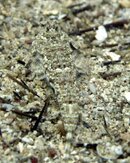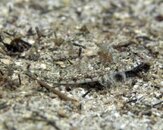itziar
Contributor
I have recently found specimens like this at about 15-20m depth on areas of sand mixed with coral rubble, inside the reefs of Veracruz (Mexico). I am at odds with the identification.
They do not have any blue dots or markings on the body, which, according to the ReefNet DVD would be an ID marking for Lancer Dragonet (Paradiplogrammus bairdi), although these blue markings are not mentioned in the REEF Fish ID book by Humann & DeLoach. The general tan-white mottled background and the orange first dorsal fin would indicate Spotted Dragonets (Diplogrammus pauciradiatus), as the ReefNet DVD suggests, but these specimens lack the fleshy keel, which is present in all photographs of Spotted Dragonet of the ReefNet series, and also an ID marking according to this material.
I have seen 3 of these, two with orange dorsal fins and one with a black dorsal fin (an orange and the black were a pair), all of them without keels or blue markings.
So what do you think, are they Lancer or Spotted Dragonets, or are they some other species?
Are blue markings always present in Lancer Dragonets? Are fleshy keels always present in Spotted Dragonets?
The only other dragonets I have seen was while diving in the Keys, and they definitely had blue markings all over.
Photos by David Hughes, La Poza, Isla Verde, Veracruz, 5/8/2011.
Cheers,
Itziar


They do not have any blue dots or markings on the body, which, according to the ReefNet DVD would be an ID marking for Lancer Dragonet (Paradiplogrammus bairdi), although these blue markings are not mentioned in the REEF Fish ID book by Humann & DeLoach. The general tan-white mottled background and the orange first dorsal fin would indicate Spotted Dragonets (Diplogrammus pauciradiatus), as the ReefNet DVD suggests, but these specimens lack the fleshy keel, which is present in all photographs of Spotted Dragonet of the ReefNet series, and also an ID marking according to this material.
I have seen 3 of these, two with orange dorsal fins and one with a black dorsal fin (an orange and the black were a pair), all of them without keels or blue markings.
So what do you think, are they Lancer or Spotted Dragonets, or are they some other species?
Are blue markings always present in Lancer Dragonets? Are fleshy keels always present in Spotted Dragonets?
The only other dragonets I have seen was while diving in the Keys, and they definitely had blue markings all over.
Photos by David Hughes, La Poza, Isla Verde, Veracruz, 5/8/2011.
Cheers,
Itziar


Last edited:




